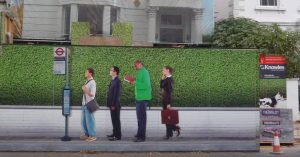From the busy streets of Trafalgar Square to the towering buildings in Tokyo, printed hoardings have been a staple in the advertising industry for centuries. These massive displays of visual communication provide an opportunity for brands to capture attention and make a lasting impression on passersby. But how did this form of advertising come to be? And what does its future hold in an increasingly digital world? In this blog post, we explore the history, impact, and evolution of the history of Printed Hoardings – from their Renaissance roots to modern-day technologies – shining a spotlight on their creative potential and undeniable presence in our urban landscapes. So buckle up and get ready for a journey through time as we dive into The History of Printed Hoardings!

The History of Printed Hoardings: An overview of the industry
Hoarding advertising has been an integral part of the marketing industry for centuries. It involves displaying large-format advertisements on hoardings, billboards or other outdoor surfaces, with the aim of attracting and engaging potential customers. The first recorded use of hoarding advertising dates back to ancient Egypt when wall paintings were used to promote goods and services.
The industry has come a long way since then, with modern-day hoardings featuring eye-catching graphics, bold typography, and vivid colours that demand attention from passersby. Today’s technology allows advertisers to create dynamic displays that can change throughout the day or be customized based on specific demographics.
Hoarding advertising is now a multi-billion pound industry that spans across the globe. From small businesses targeting local audiences to multinational corporations launching global campaigns, there are endless possibilities for brands looking to utilise this powerful form of communication.
Despite their effectiveness in reaching large audiences, hoardings have faced criticism for their impact on urban landscapes and visual pollution. As such, many cities around the world have implemented regulations regarding their size and placement.
It’s clear that hoarding advertising remains a popular choice among marketers due to its ability to capture attention quickly and effectively communicate brand messages at scale.
History of Printed Hoardings: Tips and tricks for effective communication
Designing printed hoardings is an art form that requires creativity, skill, and strategic thinking. The primary goal of designing a hoarding is to communicate your message effectively to your target audience. Here are some tips and tricks for creating powerful printed hoardings that can help you achieve this objective.
Firstly, always have a clear understanding of the purpose and goals of your campaign before you begin designing your hoarding. This will help ensure that all design elements work towards achieving those goals.
Secondly, use eye-catching visuals such as bold graphics or vibrant colours in combination with concise copywriting to grab attention quickly. Avoid cluttered designs that confuse viewers.
Thirdly, consider the placement of text and imagery carefully. Ensure they are balanced in terms of size and placed strategically so viewers read them in the optimum order.
Fourthly, ensure brand consistency by using consistent branding elements like fonts or colour schemes across multiple channels including social media campaigns or websites; this helps build credibility with audiences over time.
Make sure to test different versions of your design with focus groups or A/B testing methods before going live on billboards for maximum impact. By following these strategies while designing printed hoardings you can create effective communication pieces which meet their intended objectives while engaging audiences visually as well as through words!
The role of printed hoardings in branding and marketing
History of Printed Hoarding: An excellent tool for branding and marketing. They serve as a canvas to showcase the brand’s message, vision, and values to the public. Hoardings allow businesses to reach their target audience in a cost-effective manner by displaying their advertisements at high-traffic locations.
Printed hoardings also help brands create buzz around their products or services. By using creative designs, bold colours, and catchy slogans on the hoarding ads, businesses can generate interest and curiosity among the passersby. Moreover, printed hoardings enable companies to reinforce their brand identity and establish themselves as experts in their respective fields.
One of the benefits of using printed hoardings is that they offer long-term visibility to brands. Unlike other forms of advertising like TV commercials or radio ads that have limited airtime, printed hoardings provide round-the-clock exposure for several weeks or even months depending on the campaign duration.
In addition to this, printed hoardings are highly customizable according to specific requirements such as size, shape, and location. They can be used for announcing new product launches, campaigns, promotions, rebranding exercises etc. Printed Hoarding Advertisements potentially attract customers through calls-to-action with phone numbers, email id’s, social media hashtags etc.
The ability of Printed Hoarding Advertisements in providing wide-spread coverage makes them particularly useful in promoting events such as trade fairs, sporting competitions, music concerts, festivals etc. This versatile medium provides great results when it comes down spreading awareness about a business’ offerings. It helps increase footfall, increase sales, enables lead generation all while ensuring maximum exposure within budget constraints.
The impact of printed hoardings on urban landscapes
Printed hoardings have become a ubiquitous feature in urban landscapes. They are used to promote products and services, announce events, and even beautify construction sites. While they serve as an effective marketing tool for businesses, printed hoardings also have a significant impact on the visual environment of cities.
One major impact of printed hoardings is their ability to transform dull or unattractive spaces into visually appealing areas. Hoardings that showcase beautiful artwork can create a sense of pride and identity within communities. Moreover, these displays can help improve public perceptions of previously unremarkable places.
However, some people argue that printed hoardings detract from the natural beauty of urban environments by adding commercial clutter to streetscapes. The sheer number of advertisements may overwhelm pedestrians and cause sensory overload. Additionally, poorly designed or maintained hoarding displays can make neighbourhoods appear run-down or unkempt.
In response to this criticism, many cities have implemented regulations around the size and placement of printed hoardings in public areas. Some local governments require businesses to obtain permits before erecting outdoor advertising structures or limit where they can be located altogether.
While there are valid arguments both for and against them, it’s clear that printed hoardings play an important role in shaping our perception of urban landscapes. By designing high-quality displays that complement rather than compete with their surroundings – whether through artful visuals or strategic positioning – we can minimize negative impacts while maximizing the benefits they offer as a marketing tool for business owners both big and small alike.
Printing techniques: The advantages and limitations of different methods
Hoarding printing techniques have significantly evolved over the years, and today we have a wide range of options available for creating high-quality printed hoardings. The choice of printing technique depends on various factors such as budget, size, material, design complexity, and timeframe.
Traditionally, screen printing was used for hoarding printing due to its ability to print on large surfaces with vibrant colours. However, it is not suitable for complex designs or small quantities. Digital printing has revolutionized the industry by allowing more flexibility in terms of design and quantity while offering excellent quality at an affordable price.
UV flatbed printing is another popular technique that allows direct-to-substrate printing on rigid materials like wood or metal without compromising colour accuracy or image resolution. This method also offers waterproof and fade-resistant prints that can withstand harsh weather conditions.
However, each technique has its limitations too. For instance, digital prints may not be durable enough for long-term outdoor use compared to screen-printed ones because they are sensitive to UV rays and moisture. Moreover, some printers may struggle with precision when it comes to fine details or gradients.
In summary, choosing the right hoarding printing technique requires careful consideration of various factors such as durability requirements; design complexity; project timeline; substrate type; environmental considerations; and cost-effectiveness. Therefore it’s imperative that you always work with professional printer companies who will guide you through all these aspects while ensuring a top-quality end product that meets your specific needs.
Creative strategies for using printed hoardings in guerrilla marketing
Guerrilla marketing is all about creativity and standing out from the crowd. Printed hoardings provide an excellent opportunity to create a buzz without breaking the bank. Here are some creative strategies for using printed hoardings in guerrilla marketing.
First, consider using unexpected locations for your hoarding placement. This could be on the side of a building, on public transport, or even in nature. The key is to make it feel surprising and memorable.
Secondly, use bold colours and striking images that grab attention quickly. Think outside of the box with quirky designs that relate to your brand or product.
Thirdly, add interactive elements such as QR codes or augmented reality features to engage passersby and encourage them to interact with your advertisement.
Fourthly, consider incorporating humour into your design to create a lasting impression on viewers. People tend to remember things that make them laugh!
Utilise street art techniques such as stencilling or wheat pasting that can give your hoarding a unique look while also adding an element of urban coolness.
Incorporating these creative strategies into your printed hoarding campaign will not only help you stand out but also ensure maximum impact for minimum spend!
The ethics of hoardings: Balancing commerce and aesthetics
Printed hoardings are an effective way for businesses to promote their products or services. However, the use of hoardings raises a question about ethics in advertising.
One issue is balancing commerce with aesthetics. Advertisements should not be intrusive nor detract from the beauty and character of a place. Therefore, advertisers need to choose appropriate locations and designs that will complement the surroundings.
Another concern is the impact on society’s mental health by bombarding individuals with advertisements at every turn. Businesses have a responsibility to ensure that they are not contributing to unnecessary stress levels by overloading consumers with information.
Additionally, there are ethical considerations surrounding the content of these advertisements. Advertisers must ensure that their messages are truthful, accurate and do not promote unethical practices such as sexism or racism; otherwise it could lead to backlash and reputational damage for both advertiser and business owners alike.
Printed hoardings often contribute significantly towards environmental degradation through wastefulness in design choices, manufacturing processes and disposal methods. It is therefore important for advertisers to consider environmentally sustainable options when designing campaigns which reduce waste whilst still providing maximum value for clients’ money spent on them
Innovative applications of in art and design
Printed hoardings have found a new purpose beyond advertising and marketing campaigns. They can be used as a canvas for art installations and creative designs that engage the public in urban spaces. Artists and designers are using printed hoardings to transform blank walls into captivating works of art that reflect local cultures, histories, and identities.
History of Printed Hoardings offer an affordable solution for temporary installations while construction or renovation work is being carried out. The flexibility of printing technology allows artists to experiment with different materials, colours, textures, and sizes to achieve their desired expression. For example, printed hoardings can be used to showcase photography exhibitions or museum collections outside traditional gallery settings.
Moreover, printed hoardings provide an opportunity for community engagement by involving local residents in the creative process. Community-led design projects allow people to participate in shaping their environment while promoting social cohesion through shared experiences of artistic expression.
In addition, printed hoardings can also serve as a means of protest against social issues such as gentrification or environmental degradation. Activists use them as platforms for raising awareness about pressing problems affecting communities globally.
Innovative applications of printed hoardings demonstrate how they can transcend their commercial origins and become powerful tools for enhancing public spaces’ aesthetic appeal while fostering creativity and cultural diversity.
The future of printed hoardings: Emerging trends and technologies
As technology continues to advance, the future of printed hoardings presents an exciting opportunity for innovation and creativity. One trend that is already emerging is the use of augmented reality (AR) in hoarding designs. By integrating digital elements into physical environments through mobile devices or wearable’s, AR has the potential to transform traditional static hoardings into dynamic interactive experiences.
Another growing trend in hoarding design is sustainability. Brands are increasingly looking for eco-friendly solutions that reduce waste and promote recycling. As a result, many companies are experimenting with biodegradable materials such as bamboo-based boards or recycled plastics.
The integration of smart technologies such as sensors and data analytics also holds promise for the future of printed hoardings. By collecting real-time data on consumer behaviour and engagement with particular designs, brands can tailor their campaigns more effectively and improve their return on investment.
In addition to technological advancements, there may be changes in regulations governing outdoor advertising which could impact the industry’s future direction. For example, some cities have introduced restrictions on billboard sizes or locations due to concerns over visual pollution.
It will be interesting to see how new technologies continue to shape the form and function of printed hoardings in years to come while considering sustainability measures along with regulatory guidelines enforced by respective authorities.
History of Printed Hoardings: Logistics and best practices
Managing printed hoarding campaigns is a complex process that requires attention to detail, organization, and effective communication. From planning and designing to printing and installation, every step must be carefully coordinated to ensure a successful outcome.
To manage a printed hoarding campaign effectively, it is essential to have clear objectives in mind from the outset. Whether you are promoting a specific product or service or building brand awareness, your goals should inform every aspect of the campaign.
Next, you will need to establish timelines for each stage of the project. This includes design development, printing production, transportation logistics and installation schedules. It’s important to build in some flexibility as unexpected delays can happen at any time during this type of advertising campaign.
When choosing materials for your hoardings consider factors such as durability against weather conditions like rain or wind as well as environmental concerns (such as recycling). Additionally if you’re targeting outdoor areas then ensuring that the material is UV resistant would be an excellent consideration too!
Finally- when selecting locations for installing hoardings it’s crucial that they align with target audience demographics so that impressions are made on potential customers who match up with your desired customer base!
Printed hoardings have come a long way from their humble beginnings in the Renaissance era. Today, they are an integral part of the advertising and marketing industry, with their ability to effectively promote brands and products on a large scale.
From design tips to printing techniques, we’ve explored various aspects of printed hoardings in this article. We’ve also looked at the ethics surrounding them and how they impact urban landscapes.
As technology continues to evolve, so do the possibilities for printed hoardings. Emerging trends such as interactive digital displays offer exciting opportunities for marketers looking to engage consumers in innovative ways.
But amidst all this change, one thing remains constant: History of Printed Hoardings continue to be an effective tool for promoting brands and messages. By understanding their history and best practices for designing and implementing campaigns, businesses can create impactful campaigns that resonate with audiences.
Whether it’s through traditional print methods or cutting-edge digital displays, printed hoardings will undoubtedly remain a crucial element of advertising campaigns across industries moving forward.
If you’re in search of high-quality printed hoardings to elevate your brand’s visibility and make a lasting impression, look no further than Project Print Management. Our team of experts is dedicated to delivering exceptional results tailored to your unique needs. Don’t hesitate to reach out to us to discuss your requirements and explore the range of services we offer. For inquiries, please contact Justin Murray at justin.murray@projectprintmanagement.co.uk. We look forward to helping you transform your advertising and bring your vision to life!
For more information on History of Printed Hoardings please visit here, and for our latest print projects please visit our blog.





